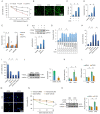Toll-like receptor 5 deficiency diminishes doxorubicin-induced acute cardiotoxicity in mice
- PMID: 33042267
- PMCID: PMC7532690
- DOI: 10.7150/thno.47516
Toll-like receptor 5 deficiency diminishes doxorubicin-induced acute cardiotoxicity in mice
Abstract
Rationale: Clinical application of doxorubicin (DOX) is limited by its toxic cardiovascular side effects. Our previous study found that toll-like receptor (TLR) 5 deficiency attenuated cardiac fibrosis in mice. However, the role of TLR5 in DOX-induced cardiotoxicity remains unclear. Methods: To further investigate this, TLR5-deficient mice were subjected to a single intraperitoneal injection of DOX to mimic an acute model. Results: Here, we reported that TLR5 expression was markedly increased in response to DOX injection. Moreover, TLR5 deficiency exerted potent protective effects against DOX-related cardiac injury, whereas activation of TLR5 by flagellin exacerbated DOX injection-induced cardiotoxicity. Mechanistically, the effects of TLR5 were largely attributed to direct interaction with spleen tyrosine kinase to activate NADPH oxidase (NOX) 2, increasing the production of superoxide and subsequent activation of p38. The toxic effects of TLR5 activation in DOX-related acute cardiac injury were abolished by NOX2 deficiency in mice. Our further study showed that neutralizing antibody-mediated TLR5 depletion also attenuated DOX-induced acute cardiotoxicity. Conclusion: These findings suggest that TLR5 deficiency attenuates DOX-induced cardiotoxicity in mice, and targeting TLR5 may provide feasible therapies for DOX-induced acute cardiotoxicity.
Keywords: Apoptosis; NOX2; TLR5; cardiotoxicity; doxorubicin.
© The author(s).
Conflict of interest statement
Competing Interests: The authors have declared that no competing interest exists.
Figures






Similar articles
-
Signalling mechanisms underlying doxorubicin and Nox2 NADPH oxidase-induced cardiomyopathy: involvement of mitofusin-2.Br J Pharmacol. 2017 Nov;174(21):3677-3695. doi: 10.1111/bph.13773. Epub 2017 Apr 22. Br J Pharmacol. 2017. PMID: 28261787 Free PMC article.
-
Adiponectin agonist ADP355 ameliorates doxorubicin-induced cardiotoxicity by decreasing cardiomyocyte apoptosis and oxidative stress.Biochem Biophys Res Commun. 2020 Dec 10;533(3):304-312. doi: 10.1016/j.bbrc.2020.09.035. Epub 2020 Sep 18. Biochem Biophys Res Commun. 2020. PMID: 32958254
-
C1qTNF-related protein 1 attenuates doxorubicin-induced cardiac injury via activation of AKT.Life Sci. 2018 Aug 15;207:492-498. doi: 10.1016/j.lfs.2018.06.029. Epub 2018 Jun 30. Life Sci. 2018. PMID: 29964055
-
The Protective Effect of Natural Compounds on Doxorubicin-Induced Cardiotoxicity via Nicotinamide Adenine Dinucleotide Phosphate Oxidase Inhibition.J Pharm Pharmacol. 2022 Mar 3;74(3):351-359. doi: 10.1093/jpp/rgab109. J Pharm Pharmacol. 2022. PMID: 34562089 Review.
-
Role of M6a Methylation in Myocardial Ischemia-Reperfusion Injury and Doxorubicin-Induced Cardiotoxicity.Cardiovasc Toxicol. 2024 Sep;24(9):918-928. doi: 10.1007/s12012-024-09898-7. Epub 2024 Jul 18. Cardiovasc Toxicol. 2024. PMID: 39026038 Review.
Cited by
-
m6A demethylase ALKBH5 attenuates doxorubicin-induced cardiotoxicity via posttranscriptional stabilization of Rasal3.iScience. 2023 Feb 16;26(3):106215. doi: 10.1016/j.isci.2023.106215. eCollection 2023 Mar 17. iScience. 2023. PMID: 36876119 Free PMC article.
-
Flagellin-Induced Immune Response in Human-Induced Pluripotent Stem Cell-Derived Cardiomyocytes.Int J Mol Sci. 2023 Sep 11;24(18):13933. doi: 10.3390/ijms241813933. Int J Mol Sci. 2023. PMID: 37762236 Free PMC article.
-
Protection against Doxorubicin-Related Cardiotoxicity by Jaceosidin Involves the Sirt1 Signaling Pathway.Oxid Med Cell Longev. 2021 Aug 6;2021:9984330. doi: 10.1155/2021/9984330. eCollection 2021. Oxid Med Cell Longev. 2021. PMID: 34422218 Free PMC article.
-
Semaglutide ameliorates cardiac remodeling in male mice by optimizing energy substrate utilization through the Creb5/NR4a1 axis.Nat Commun. 2024 Jun 4;15(1):4757. doi: 10.1038/s41467-024-48970-2. Nat Commun. 2024. PMID: 38834564 Free PMC article.
-
Achillea millefolium ameliorates doxorubicin-induced renal injury via inhibition of oxidative stress and inflammation in rats.Turk J Med Sci. 2024 Sep 18;54(6):1389-1398. doi: 10.55730/1300-0144.5922. eCollection 2024. Turk J Med Sci. 2024. PMID: 39734352 Free PMC article.
References
-
- Carvalho FS, Burgeiro A, Garcia R, Moreno AJ, Carvalho RA, Oliveira PJ. Doxorubicin-induced cardiotoxicity: from bioenergetic failure and cell death to cardiomyopathy. Med Res Rev. 2014;34:106–35. - PubMed
-
- Carvalho RA, Sousa RP, Cadete VJ, Lopaschuk GD, Palmeira CM, Bjork JA. et al. Metabolic remodeling associated with subchronic doxorubicin cardiomyopathy. Toxicology. 2010;270:92–8. - PubMed
-
- Lefrak EA, Pitha J, Rosenheim S, Gottlieb JA. A clinicopathologic analysis of adriamycin cardiotoxicity. Cancer-Am Cancer Soc. 1973;32:302–14. - PubMed
-
- Ibrahim NK, Hortobagyi GN, Ewer M, Ali MK, Asmar L, Theriault RL. et al. Doxorubicin-induced congestive heart failure in elderly patients with metastatic breast cancer, with long-term follow-up: the M.D. Anderson experience. Cancer Chemother Pharmacol. 1999;43:471–8. - PubMed
-
- Von Hoff DD, Layard MW, Basa P, Davis HJ, Von Hoff AL, Rozencweig M. et al. Risk factors for doxorubicin-induced congestive heart failure. Ann Intern Med. 1979;91:710–7. - PubMed
Publication types
MeSH terms
Substances
LinkOut - more resources
Full Text Sources
Miscellaneous

